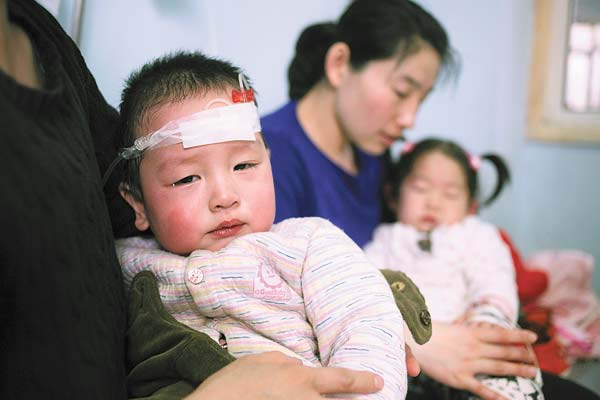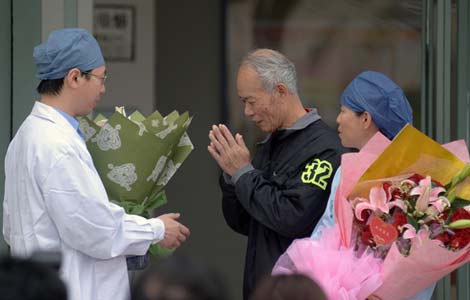Flu awareness comes in from the cold
Updated: 2013-01-29 02:06
(China Daily)
|
||||||||
In 1998, Beijing's funeral services were strained by a higher-than-average number of flu-related deaths, said He Xiong, deputy director of the Beijing Center for Disease Control and Prevention.
"I got a call from the Beijing civil affairs department asking why there had been more deaths than usual. I told them that it was because of a higher incidence of flu," recalled He.
 |
|
Li Jia, 18 months old, recieves intravenous medication to tackle flu symptons at Ritan Children's Hospital in Beijing. [Wang Jing/China Daily] |
However, despite greater awareness over recent years, "many people are still unable to distinguish flu from a common cold and therefore greatly underestimate the hazard it poses", he warned.
So far this winter, eight flu-related deaths have been reported in China, seven of them in Beijing, according to the Ministry of Health.
On Dec 27, a 22-year-old migrant worker, infected with the H1N1 strain, died, becoming the first flu-related fatality in Beijing of the winter.
According to the Beijing CDC, on Dec 25 the woman had a severe cough but by the next day had developed a high fever.
Because she had difficulty breathing, the patient was sent to the Beijing Chaoyang Hospital on Dec 27, but she later died as a result of acute respiratory failure.
According to reports, the patient was anemic and in poor health when she became infected. The same was true of a second victim of H1N1, a 65-year-old woman in the terminal stages of bone marrow cancer, who died on Jan 4. Neither of them had received a flu vaccination.
The number of cases of flu and related fatalities in Northern China is expected to rise before winter ends, according to Shu Yuelong, director of the National Influenza Center, under the Chinese Center for Disease Control and Prevention.
Cold, dry winters often see a rise in the incidence of flu, according to He Xiong. That rise is exacerbated by the fact that people tend to spend more time indoors, further increasing interpersonal contact, particularly in public places, and allowing more opportunities for the virus to spread, he added.
"Spring Festival, which sees a huge number of people take to the roads for family reunions, also increases the risk," he warned.
From a socioeconomic point of view, the illness "likes the rich but is isolated from the poor", he said, pointing out that the spread tends to be wider in places where economic activity and interpersonal contacts abound. "It's complex and has both natural and social determinants."
Shu was of the same opinion, but ruled out the possibility of a flu pandemic this year because there have been no mutations to the known viruses. The H3N2 and H1N1 strains have predominated this season, with H1N1 being more prevalent in Beijing, he said.
"So far, flu activity is within the normal range compared with previous years and people are familiar with the dominant viral strains," he said, adding that surveillance is ongoing.
Flu surveillance network
China has 556 flu surveillance stations nationwide, mainly in hospitals. Samples collected at the sites are sent on to labs run by the China CDC and regional branches for final checks.
Shu said that most of the hospitals lack the facilities to conduct the tests themselves and that "the majority of cases don't need to be tested in a lab to ascertain whether they were caused by flu viruses or not".
Under the current network, every week each "sentry" hospital is required to send samples of five to 15 flu-like cases to designated labs, and report related information for further analysis, he explained.
"The key to our surveillance is to detect an emerging epidemic trend and potential viral mutations in good time, to issue health warnings and to help the decision makers prepare the appropriate response," said Wang Quanyi, director of the infectious disease institution of the Beijing CDC.
In Beijing, the local authorities began sending health-related text messages to mobile phone users, focusing on flu prevention tips.
Most of the cases have been mild and patients recover fully in around two weeks, according to experts. But for children, the elderly and those suffering from chronic diseases, the illness can lead to serious complications or even death.
"We should be on high alert, particularly in the face of new trends", stressed He.
In 2009, an outbreak of H1N1, a little known strain at the time, led to around 18,000 deaths globally, according to the World Health Organization.
Low awareness
Public awareness of flu has risen in tandem with the improvement in surveillance capability that followed the SARS outbreak of 2003, said Wang.
However, he conceded that understanding of the illness remains relatively limited, even among medical professionals.
A study conducted by the China CDC in 2012 discovered that seasonal flu was responsible for more deaths in the country than had previously been thought. The study, based on data from eight cities with especially accurate mortality figures, showed that between 2003 and 2008, a large number of deaths that had originally been attributed to respiratory and circulatory failures were actually caused by flu and that in 86 percent of cases, the victims were aged 65 and older.
Also, unlike the United States where the H3N2 virus caused most flu-related deaths, the Influenza B virus led to most of the deaths on the Chinese mainland, according to the report.
Worryingly, most people in China mistook cases of flu for common colds, said He. That may be caused, in part, by a linguistic quirk, he said: In Mandarin flu is called liugan, which means "infectious cold" and is derived from the word for common cold. However, unlike the common cold, flu tends to produce more intense symptoms and much more serious complications or even death, according to He.
"That's the reason why we have to pay special attention to viral infections and carry out interventions to avert any extra deaths caused by a flu epidemic," he said.
Demand for inpatient care, particularly among the elderly and those with underlying chronic conditions, usually increases substantially in flu season, further straining limited medical resources and other related sectors, according to He.
An epidemic can take an economic toll through lost or reduced productivity, and also strain medical and related services, he warned.
Ma Anlin, deputy director of the department of infectious diseases at the China-Japan Friendship Hospital in Beijing, said the hospital's fever clinic is receiving an average of around 300 people a day, many more than earlier in the winter.
Most outpatients have fevers, headaches and sore throats that may be attributable to flu, he said.
Wang Yan, the hospital's respiratory specialist, said she has to work a 24-hour shift on alternate days in response to the rising number of patients. "Sometimes, more than 30 people will be admitted after midnight," she said. "I am exhausted through lack of sleep."
Consulting a doctor is the wise choice for people with serious flu-like symptoms, she said, emphasizing the first 24 hours after the onset are crucial for effective treatment.
A World Bank study in 2008 estimated that a flu pandemic could cost $3 trillion and cause a roughly 5 percent drop in global GDP.
Also, at least 70 million people could die worldwide in a severe pandemic, it estimated.
During the 2003 SARS outbreak, the epidemic halted travel, trade and workplaces and cost the Asia-Pacific region $40 billion, according to the WHO. The six-month-long outbreak killed 775 people in 25 countries.
Vaccination
Vaccination is the most effective means of prevention, said Shu. However, a series of misunderstandings have resulted in less than 2 percent of the Chinese population receiving an annual flu shot.
Wang Quanyi said the virus will continue to spread because too few people are willing to be vaccinated. "It is so hard to talk people into taking flu shots," he said. "People refuse, even if the healthcare workers knock on their doors and offered free vaccine."
"Many people simply don't bother to get vaccinated because they don't take flu seriously," said Shu.
Meanwhile, others fear potential adverse reactions.
In 2009, around 800 children, mainly in Sweden but also in other parts of Europe, developed narcolepsy, a neurological disorder, after being vaccinated with the Pandemrix H1N1 swine flu vaccine made by the drugmaker GlaxoSmithKline, according to reports by Reuters.
"So far, a link between the two cannot be substantiated and that shouldn't prevent people from taking the flu shot for proven protection," He noted.
Under the nation's vaccination programs, people have to pay for flu shots.
"A free nationwide service would help boost the coverage quite a lot," He said.
In 2007 in Beijing, the local government began a program to vaccinate students and the elderly free of charge every year.
Since then, an average 1.7 million from those groups in the capital have received the shot during the flu season, said He.
The figure before that fluctuated quite a lot, from 1 million to 1.8 million, "which affected a sustainable flu intervention effort on the whole", he said, stressing "the money is worth paying."
Every yuan the government spends on vaccination may help save 10 yuan ($1.60) in flu-related medical expenditure, said He, citing a study conducted in 2008. The first groups to receive the shots should include children aged between 6 months and 5 years, people aged 60 and older, sufferers of chronic diseases, pregnant women, medical and kindergarten workers, according to the China CDC's recommendations.
These groups totaled 570 million on the Chinese mainland, around 43 percent of the population, according to Feng Luzhao, a researcher with the China CDC's infectious disease prevention and control department.
A 2009 survey conducted by the China CDC showed vaccination coverage in areas of relative wealth is higher than in underprivileged regions.
Overreaction?
Sniffling, groggy and frightened, Zhao Yanwei had flu. The 28-year-old Beijing resident dragged himself to the China-Japan Friendship Hospital but found the fever clinic was packed with patients, coughing and wheezing.
Zhao had been running a temperature as high as 39C for two days, but the medicine he bought from a pharmacy hadn't worked. "I have never thought of getting vaccinated," said Zhao, who wore a protective mask. "I would have got the shot if I had known the flu would bring so much pain."
Yu Xin, who also had flu-like symptoms, said he hadn't had the shot and had no intention of doing so.
"Don't you think people overreact to a cold?" he asked. "Besides, it needs to be done every year. How do you know the vaccine is safe and won't cause any side effects?"
Contact the writers at shanjuan@chinadaily.com.cn and pengyining@chinadaily.com.cn

 Li Na on Time cover, makes influential 100 list
Li Na on Time cover, makes influential 100 list
 FBI releases photos of 2 Boston bombings suspects
FBI releases photos of 2 Boston bombings suspects
 World's wackiest hairstyles
World's wackiest hairstyles
 Sandstorms strike Northwest China
Sandstorms strike Northwest China
 Never-seen photos of Madonna on display
Never-seen photos of Madonna on display
 H7N9 outbreak linked to waterfowl migration
H7N9 outbreak linked to waterfowl migration
 Dozens feared dead in Texas plant blast
Dozens feared dead in Texas plant blast
 Venezuelan court rules out manual votes counting
Venezuelan court rules out manual votes counting
Most Viewed
Editor's Picks

|

|

|

|

|

|
Today's Top News
Boston bombing suspect reported cornered on boat
7.0-magnitude quake hits Sichuan
Cross-talk artist helps to spread the word
'Green' awareness levels drop in Beijing
Palace Museum spruces up
First couple on Time's list of most influential
H7N9 flu transmission studied
Trading channels 'need to broaden'
US Weekly

|

|







